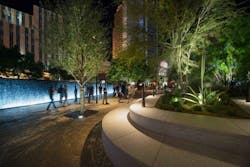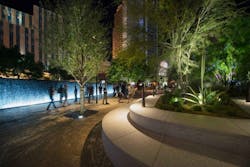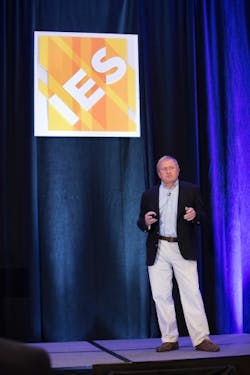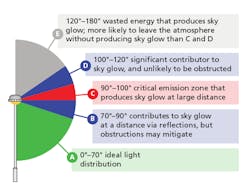Connectivity and smart lighting remained a theme at the Street and Area Lighting Conference, but MAURY WRIGHT reports that outdoor light quality and protection of the dark sky were the more compelling topics at the 2018 event.
The Illuminating Engineering Society (IES) Street and Area Lighting Conference (SALC) took place Oct. 1–3 in Orlando, FL and the program as usual provided attendees with the latest thinking on safe but energy-efficient solid-state lighting (SSL) for streets and outdoor public spaces. The conference seemingly turned a corner this year, with LED light quality and spectral power distribution (SPD) of luminaires being more compelling topics than smart lighting. Indeed, the engineers and specifiers working in the outdoor lighting space will encounter the challenge of pleasing many constituents, delivering safe environments for citizens yet preserving the ability of observatories to perhaps provide a totally different type of safety.
City of Orlando
As has become customary, SALC 2018 started with a presentation from a local municipality official who discussed the unique aspects of Orlando. Ian Lahiff is an energy project manager with the City of Orlando, and he began with a characterization of the people in the city at any given point. Surprisingly, the city population is only 277,000. But in 2017, the city drew 72 million visitors, making it the most visited city in the western hemisphere.
Indeed, the city has one resident for every 245 tourists, and a large segment of residents live at or near the poverty level, subsisting on service industry jobs. The makeup of the city places unique demands on decisions that must be socially equitable yet promote sustainability and energy efficiency, and further impact lighting.
The mayor of Orlando, Buddy Dyer, created a task force in 2007 called Green Works Orlando, and that effort has led to several notable projects. For example, the city owns and operates its sports and entertainment venues directly, including the Amway Center that hosts the Orlando Magic basketball team and the Camping World Stadium football venue.
The downtown Amway Center hosts events such as concerts, minor league hockey, and more in addition to basketball — more than 300 events each year, according to Lahiff. Previously, there were multiple legacy lighting systems installed with separate systems used for different types of events. In 2017, the city retrofitted the lighting, working with Musco Lighting to install a unified LED-based system with controls that enable the single system to serve all events.
The project has improved the visitor experience while also slashing energy usage that will essentially save money in the long term for taxpayers. And moving to a unified system of long-lifetime SSL products will slash maintenance costs as well. The system came with a 10-year parts and labor warranty.
Lahiff said a key project underway right now is a $20 million renovation of City Hall that includes a floor-by-floor retrofit, including conversion to LED lighting with daylight harvesting and a building automation system. The city has built a 40-MW solar farm. Going forward, Lahiff said the city is committed to being a smart and interconnected city with an Internet of Things (IoT) infrastructure and intends to install smart street lights across every district.
Amusement park central
The Orlando presentation was a perfect lead-in to the SALC keynote presentation by Chip Israel (Fig. 1), president of LDA (Lighting Design Alliance). Israel has been involved in numerous major lighting projects at Disney and other amusement parks and themed hotels, and presented a talk entitled “Dynamic Lighting for Event Spaces/Theme Parks.” The keynote had only a small tie to street or roadway lighting but was packed with insight into area lighting practices.
Israel began with the statement that “Nothing is new, but everything has changed.” The message was that the goals of impactful and effective lighting have always been the same. But the LED revolution is providing many new ways to accomplish the long-understood goals. He quipped that the smartphone has changed things in lighting the most because of the selfie trend and the move away from what he termed the old “Kodak moment.” Good lighting should enable good selfies in this age.
FIG. 1. Chip Israel of the Lighting Design Alliance (LDA) discussed the impact of LEDs on theme park and event space lighting in the SALC keynote address. (Photo credit: LDA.)
As he got into his message, Israel handed an object to the front row and asked each person to look at the object and pass it along to the next person, and promised he would explain the significance later. What was the object? It was simply a quarter and we will get to that shortly.
Turning to the subject of a theme park, Israel said there are things we can do with lighting that we can’t do with color or texture. He used as an example the Tower of Terror Disney attraction where he said projected light creates the perception of depth and exposes the architecture of the structure to great effect. Israel said, “It becomes magical.”
Impact over efficiency
He said the transition to SSL allows lighting designers to create such impact more effectively, and that attribute is far more important than the LED efficiency advantage in settings such as theme parks. He noted the longevity of LEDs has also been a huge advantage, because lighting is used for long hours each night and the small size of LED sources and availability of multiple color channels offer great flexibility.
The goal of a lighting designer in a theme park is similar to that in an architectural lighting project. “Light what you want to see,” said Israel. The best projects are ones in which you don’t see the lighting. Israel noted that on Disney’s Main Streets there are light poles behind the building façades to illuminate the façades on the opposite side of the street, but you don’t see those poles during the day. Disney has used hydraulic and manual techniques to lower and hide the poles when not in use. Disney also hides light fixtures in plain sight within façades, decorative structures on poles, and more.
Israel said that in good installations, each luminaire has a purpose. That was far harder to accomplish before SSL and especially modern lighting controls. Before a designer had access to precise dimming, you had to lower light levels by turning some fixtures off, but doing so can create uniformity problems and SSL has solved those issues.
Parades at parks have also evolved considerably. Israel said, “LEDs have been a game changer” in such applications. Where once all lighting was projected from poles, now floats and participants in parades are lit via integrated LEDs. He added, “People can wear the light and the batteries are much smaller.”
Light levels and uniformity
Getting back to the quarter passed through the crowd, Israel called it a “lighting instrument” and moved to the topic of required light levels. Now the SALC crowd is entranced by recommended practices in terms, for instance, of specific light levels and uniformity for different categories of streets. So Israel’s next statement surely caused some consternation in the room. He said flip a coin and if you can discern whether it lands on heads or tails, then you have sufficient light.
Israel described a project he worked on at a Disney resort hotel modeled after an old lodge. He said the team lit the street with 25W fluorescent sources, and that the goal was not to light the road but to outline it and focus on the pedestrian walkway.
Projects should not strive for perfect uniformity on streets and event surfaces, according to Israel. He said you should not leave complete dark spots but that contrast is a good thing. Moreover, he said vertical illumination on surfaces can make people feel like there is more light in a space and feel safer. He said we should light spaces for people and “they have to want to come back.”
Moving toward the end of the keynote, Israel used a project along a walkway on the MGM property in Las Vegas to make an example. The concept involved hiding the pedestrian lighting in a water feature along the walkway (Fig. 2). The owner had insisted that they needed an average of 2 fc of light from the fixtures, but the designers argued for less. Ultimately, the design team convinced the owner to install controls that would enable dimming. And the SSL implementation is generally operated at 0.25 fc today yet delivers plenty of light for pedestrians.
FIG. 2. Pedestrian lighting at a Las Vegas resort is hidden in a water feature; a surprising 0.25 fc per fixture delivers sufficient and safe lighting. (Photo credit: LDA.)
Blue spectrum and uplight
Moving to more typical SALC fare, there was a cautionary element to many of the SALC presentations, although the mission of much of the attendance is increasing public safety via outdoor lighting at night. Still, the group clearly recognizes the fact that blue spectrum and light pollution remain contentious issues.
Bruce Kinzey, a research engineer with the US Department of Energy (DOE) Pacific Northwest National Laboratory (PNNL) and chair of the IES sky-glow calculations committee, made a presentation that examined some research warning of more light pollution and offered insight into PNNL work that can allow specifiers to gauge the impact of a lighting plan.
Kinzey started by noting that 80% of the global population lives on less than $10 per day and has no access to personal light at night. And the lack of electricity in many regions mean there is no light across large parts of Africa and other regions. But alarmists warn that more regions are gaining electrical access.
Kinzey cited a report published in 2017 in the journal Science Advances entitled “Artificially lit surface of earth at night increasing in radiance and extent,” sometimes called the Kyba study for the lead author. That study asserts that upward light increased 2.2% annually over the years 2012–2016. The increase is presumably due to two factors. The research said 1.2 billion people got new access to electricity during the period studied, and that society uses more light as the cost of use goes down. Over the last 300 years, countries have consistently spent 0.7% of GDP on light, according to the research.
But an actual examination of SSL installation and usage in the US does not fit with the theory in the report. Kinzey showed data gathered by Navigant Research that found penetration of LEDs into US street lights had reached 6.6% in 2012 and climbed to 28.3% in 2016. And most of that installed base was at a CCT of 4000K with generally more blue energy than what is mostly being installed today. Still, upward radiance was found stable over the four-year period in the US, indicating that the US was not using more light despite having access to SSL that costs less to operate.
Sky glow tool
The DOE also published a report on sky glow in 2017 and PNNL has recently completed work on its sky glow comparison tool. The DOE report did not find any issues with LEDs that emit more blue energy than legacy sources such as high-pressure sodium (HPS). Indeed, the report concluded that to minimize sky glow, specifiers should install products that generate no uplight first, and reduce light levels where possible second. A third priority would be consideration of changing the spectral content.
The sky glow tool, meanwhile, provides some excellent insight into the situation. The tool is a spreadsheet based on more than 215,000 iterations of data run through a sky glow model and it will allow you to compare the SPD of any light source against a baseline. The model is based on sky glow experienced 25 miles away from a source.
Tests of HPS and LED lighting at a range of CCTs shows very little variation in sky glow so long as there is no uplight. Kinzey said an HPS source with only 2% uplight would have far more impact on sky glow than any LED source compared with a controlled downward beam. And he asserted that conclusion would remain true despite the fact that light reflected from a street or other surface can also add to sky glow.
Still, it’s clear there will be more lighting installed going forward, and globally society needs to prepare for that fact and take steps to mitigate sky glow. And at the same time, global society must minimize energy usage. There are always tradeoffs in lighting options. A move to amber LEDs in street lights might reduce sky glow, according to Kinzey. But those LEDs would add a 50% efficacy penalty and people would not see as well under that lighting, which decreases safety. A better option would be decreasing white light levels, but as he lamented, potential legal liability is holding back cities from trying to reduce levels.
Dark sky needs
Of course, one might ask why sky glow matters so much to dark sky proponents. It’s easy to dismiss dark sky demands as simply a preference. But Richard Wainscoat (Fig. 3), an astronomer at the University of Hawaii, explained the global safety angle that goes well beyond stargazing as a pleasurable pastime.
Wainscoat began by observing that the once world-class Palomar Observatory in southern California has been “ruined” by lights in Los Angeles and San Diego. He said, “We need every light around an observatory to be the best possible light source.”
Wainscoat is working primarily on NASA-funded projects intended to detect dangerous objects that might impact Earth. He said Congress has directed NASA to be able to detect 90% of objects measuring greater than 140m in diameter. And the SALC presentation detailed the threat. In 2013, a 20m asteroid struck Russia — fortunately, in a remote region — generating the equivalent energy of 500 ktons of TNT.
FIG. 3. Richard Wainscoat of the University of Hawaii explained that blue spectral energy interferes with the mission of detecting objects that might strike the earth. (Photo credit: LDA.)
Two telescopes in Hawaii are critical to discovering objects — Pan-STARRS1 is used to detect near-Earth objects, and Atlas are new telescopes at two locations designed to provide a few days of warning prior to an asteroid strike. The Pan-STARRS1 detected the 600m Halloween Asteroid that passed near Earth in 2015. Wainscoat said impact by an object that large would be globally catastrophic.
The real focus of Wainscoat’s presentation, however, was on how good lighting practices and good lighting for observatories aren’t mutually exclusive. He explained why blue spectral energy interferes with telescopes. Modern telescopes use blue-green filters in the 400–550-nm range to detect faint objects because the natural sky is very dark in that range. Wainscoat said all outdoor lighting should be fully shielded, eliminating uplight, but he noted even reflected blue energy is an issue for observatories.
Wainscoat hit some of the same themes as Kinzey. He said light levels need to be lowered and there should be better use of controls. He quipped that schools leave security lights on all night at full brightness and don’t use occupancy sensing. He said, “The bad guy would be more noticeable if the lights came on when he entered the school.” Fig. 4 depicts the ideal emission maxing out at 70° and illustrates the issues with emission at higher angles.
FIG. 4. Astronomers would prefer that all outdoor lighting be directed at an angle of 70° or less, and lighting just above 90° is a bigger issue than direct uplight that passes through the atmosphere.
The option of other light sources also appeals to Wainscoat, although he knows that cities will not go back to HPS. He said blue filters can be utilized with white LEDs with a minimal efficacy penalty. We covered that approach in a recent story about lighting near an observatory in the Canary Islands. He said amber LEDs would not be acceptable at efficacy in the 30-lm/W range. But he pointed out that phosphor-converted amber LEDs are nearing 100 lm/W and can offer CRI around 54 — far better than HPS sources. Also, luminaires that mix white and amber LEDs may be an option.
Controls and the IoT
Reading to this point, you are probably wondering where the coverage is of presentations focused on connected smart outdoor lighting and the IoT movement. For several years, those have been the prevailing themes of our SALC coverage. There were presentations aplenty on the topic this year but not a lot of new ground covered (see our news story on the opening of this year’s SALC).
There was a presentation by Adam Miles (Fig. 5), associate traffic engineer for the City of Spokane, that includes some interesting information on a pilot connected lighting project, revealing logistics issues cities face in LED retrofits and a cautionary return-on-investment angle relative to the controls.
Miles said cities need to view the lights throughout an entire city as a single lighting system in terms of the experience of the residents. But the reality is that there are often multiple entities involved and many different technologies. In the Spokane case, Fig 6 shows that the city owns and maintains some of the lights in the downtown area while the local utility owns and maintains others.
FIG. 5. Adam Miles from the City of Spokane revealed that a pilot controls project resulted in a return on investment scenario that would requires 12 years to reach payback. (Photo credit: LDA.)
Miles said all the lights should match in terms of CCT, and if dimming is used, then the dim levels should match as well. But in his trial, the city was only able to address its own lights initially and will attempt to include the utility-owned lights in a later phase. The two systems use disparate electrical schemes, communication schemes, and billing.
But Miles and his team wanted to test the benefits of dimming. The installation used a programmatic control to reduce light levels to a medium setting at midnight. Lack of traffic could autonomously cut levels further to a low setting. But he said that low level was sparsely achieved. The dimming scheme delivered energy savings in the 35% range beyond the baseline savings of using LEDs. But with hydroelectric power cheap in the area, that level of savings equated to $1 dollar per day per light. Miles said payback just for the dimming feature would take around 12 years.
FIG. 6. Cities should strive for uniformity in outdoor lighting despite the fact that one entity doesn’t own all of the lights. In Spokane, the city owns and operates some of the lights and a local utility others.
Still, there may be controls and connectivity in Spokane’s future. Miles also tested the use of cameras to capture traffic data. For now, however, the city plans to wait for prices to fall for smart lighting.
Roadblocks to a connected future
Clearly, roadblocks remain for connected lighting and smart cities despite the potential benefits. Jay Sachetti, product and marketing leader at Eaton, and Martin Mercier, professional system product manager at Signify, made a joint presentation about open standards being the catalyst that will drive adoption.
There is a famous graph created by Gartner that described the hype cycle of new technologies. New things go through a boom period in terms of expectations, topping out at the “peak of inflated expectations.” That peak is followed by the “trough of disillusionment,” which is where the SSL controls sector is right now, according to Sachetti. But he reminded attendees that the “slope of enlightenment” would turn the prospects back to positive soon.
Unfortunately, the standards that Sachetti and Mercier discussed were primarily applicable internal to the luminaire design. Examples include the interfaces for a modular dimming controller, internal communications scheme, and interface for a sensor module. The duo depicted ten alternatives, however, for what they termed “outra-luminaire” communications or the network that connects luminaires to a central management system. And, of course, neither connectivity scheme covers software protocols that would enable interoperability among products from multiple vendors, although as we covered, the TALQ Consortium is working on that issue.
Quality lighting outdoors
Perhaps the best news from SALC came in the form of improved quality of light. That theme has pervaded many LED and SSL conferences of late. LEDs are getting better, optics are improving, and engineers and specifiers are learning from past mistakes. Indeed, LEDs and SSL passed through the trough of disillusionment quite some time ago. One might argue that LEDs and SSL have generally reached the “plateau of productivity.”












